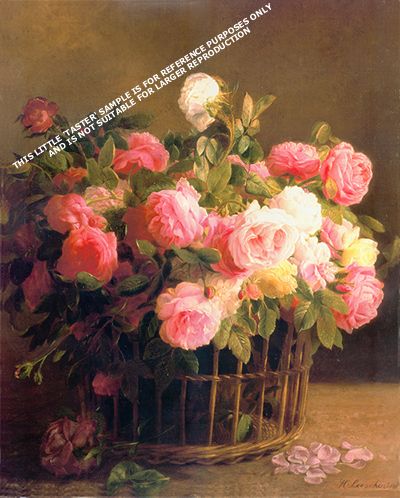|
263
'A BASKET OF FLOWERS'
By Hans Looschen (1859-1923)
 Look
at this picture for a minute or so. You are seeing a simple
basket of Old Roses painted with such feeling over a hundred
years ago. These roses are heavily scented. If you take an
imaginary deep breath, you will smell the rich and powerful
fragrance of this display wafting from the last century. It
may invoke in you a vision of an old summer room in a Victorian
country house. Not half an hour ago, our unseen lady had arrived
heavily laden with fresh-cut flowers from the garden outside,
and produced this arrangement for the house. Indeed such an
abundance could only come from a long established and probably
large garden, dripping with floral cascades. The room would
be cool and imbued with intoxicating fragrance. Look
at this picture for a minute or so. You are seeing a simple
basket of Old Roses painted with such feeling over a hundred
years ago. These roses are heavily scented. If you take an
imaginary deep breath, you will smell the rich and powerful
fragrance of this display wafting from the last century. It
may invoke in you a vision of an old summer room in a Victorian
country house. Not half an hour ago, our unseen lady had arrived
heavily laden with fresh-cut flowers from the garden outside,
and produced this arrangement for the house. Indeed such an
abundance could only come from a long established and probably
large garden, dripping with floral cascades. The room would
be cool and imbued with intoxicating fragrance.
 In
this picture we have a selection of identifiable roses - all
popular during Victorian times. They contain more interest
than just appearance alone. The pale flowers in the centre
of the display are "ROSA CENTIFOLIA", otherwise
known as the "Roses with a Hundred Leaves" or "The
Providence Rose". This was first recorded prior to 1600.
The deep pink flowers on the left are "ROSA BULLATA"
or "The Lettuce-leaf Rose" and bred as a curiosity
in 1801. The pink Roses at the Top right are "ROSA HERMOSA"
bred by Marsheseau in 1840, and the yellow roses below are
"KRONPRIZESSIN VIKTORIA". This was a "Sport"
- a happy chance from the rose "SOUVENIR DE LA MALMAISON",
- a repeat-flowering bourbon. This was introduced into France
by a German called Spath in 1887 and was one of the first
ever roses to bear this shade of colour. At the very top is
another pale rose identified as "COMTESSE DE MURANAIS",
a damask rose bred by Georges Vibert in 1843. In
this picture we have a selection of identifiable roses - all
popular during Victorian times. They contain more interest
than just appearance alone. The pale flowers in the centre
of the display are "ROSA CENTIFOLIA", otherwise
known as the "Roses with a Hundred Leaves" or "The
Providence Rose". This was first recorded prior to 1600.
The deep pink flowers on the left are "ROSA BULLATA"
or "The Lettuce-leaf Rose" and bred as a curiosity
in 1801. The pink Roses at the Top right are "ROSA HERMOSA"
bred by Marsheseau in 1840, and the yellow roses below are
"KRONPRIZESSIN VIKTORIA". This was a "Sport"
- a happy chance from the rose "SOUVENIR DE LA MALMAISON",
- a repeat-flowering bourbon. This was introduced into France
by a German called Spath in 1887 and was one of the first
ever roses to bear this shade of colour. At the very top is
another pale rose identified as "COMTESSE DE MURANAIS",
a damask rose bred by Georges Vibert in 1843.
 By
far the most interesting is the little dark-red rose hiding
in the shadows at the top left. This is a Gallica called "ROSA
GALLICA OFFICINALIS", also known as "The Apothecaries
Rose" as it was mainly grown for its medicinal properties.
But importantly it was chosen as a symbol of the Royal House
of Lancaster. By
far the most interesting is the little dark-red rose hiding
in the shadows at the top left. This is a Gallica called "ROSA
GALLICA OFFICINALIS", also known as "The Apothecaries
Rose" as it was mainly grown for its medicinal properties.
But importantly it was chosen as a symbol of the Royal House
of Lancaster.
This "Red Rose of Lancaster" has a most fascinating
history. - In the thirteenth century, Thibault de Chansonnier,
the French King of Navarre was returning from one of the Crusades
when he spotted this rose growing wild in the village of Provins,
south east of Paris. Of all the bounty he brought back from
the holy wars he was more proud of this simple flower found
in his own native land. In 1260 he wrote a poem about it to
his Queen and entitled it "Le Roman de la Rose".
 So
in this romantic picture we can see not just the beauty of
the roses themselves, but reflect on their exciting history
with further delight. We will just have to imagine the magic
of their fragrances. So
in this romantic picture we can see not just the beauty of
the roses themselves, but reflect on their exciting history
with further delight. We will just have to imagine the magic
of their fragrances.
 Hans
Looschen was a German genre painter who was born and died
in Berlin. He also painted portraits and flower studies and
exhibited works from 1888. Hans
Looschen was a German genre painter who was born and died
in Berlin. He also painted portraits and flower studies and
exhibited works from 1888.

|
